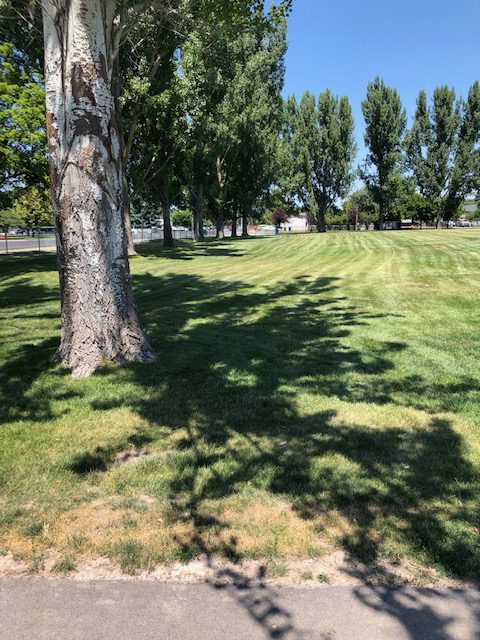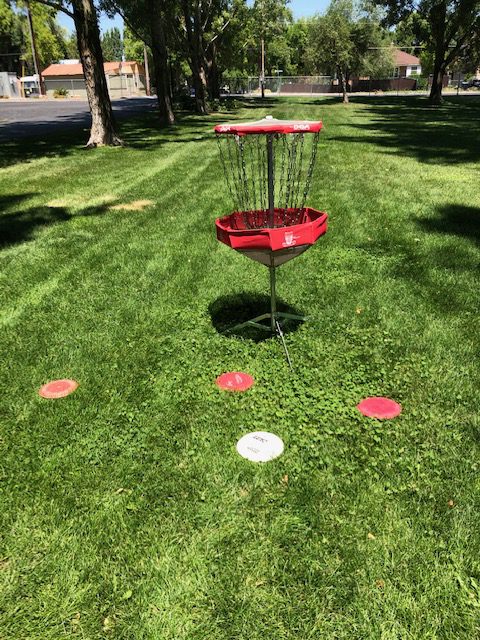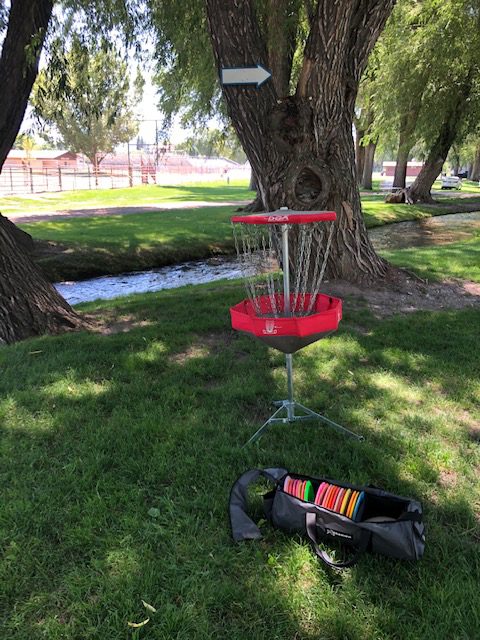
Getting Better at Disc Golf
Few people who play this sport don’t care if they improve their skills. Most of us would love to add a few more feet to our drive or increase our putting percentage. For those of us who play in leagues and tournaments, we would love to place higher and win more competitions. In fact, in a recent blog post, we learned that the number one thing that would motivate someone who doesn’t play tournaments to sign up for one, is if they were a better player. (Survey Results: Tournaments) One of the best ways to get better is with disc golf practicing. Whether we are improving enough to feel confident about playing in a tournament, or watching our PDGA rating climb high enough to step up to the next division, one of the more satisfying aspects of disc golf is to see improvement in our game.
Practice makes perfect?
To be clear, playing a round of disc golf is still practicing. The more you play, the better you will get. However, for this blog, when I say ‘disc golf practicing’ I am referring to field work and putting. From what I’ve seen and experienced, those will give your game the most rapid improvement. They take a little more discipline, because they aren’t as fun as playing a round. But, you will definitely see the most improvement with field work and putting practice.
Preparing to Practice
In this blog, I will talk about the best way to carve up your limited disc golf practice time, a couple of practice methods, and one aspect of practicing that I don’t feel is covered sufficiently, warming up. Most people, at the very least, try to get some practice throws and putts in before a league or tournament, if not some stretches. But, how many of us take the time to stretch before ripping some drives in a field or putting inside the circle? I believe that even before putting we should do some stretches. Although the risk for injury is practically nonexistent with putting, it is the consistency we are striving for.
Professional disc golfers suggest that we keep our routine consistent in practice and competition. Do the same pre-throw or pre-putt routine. Have the same mental thoughts and affirmations run through our head. Try to get the same motion in practice that we use on the course. The point of practice is to get that consistency. And if that is our goal, our muscles should be stretched and warmed up for practice the same as when we compete. That isn’t always easy. Most of us have to squeeze in some practice time in our busy schedule. Who wants to use that time stretching?
Seth Munsey of disc golf strong commented on warming up before practicing. He said, “It is very important to warm your body up properly before engaging in any athletic movement. This includes fieldwork and time spent around the practice basket. Warming up will help lower your risk of injury and allow you to tap into more of your athletic potential.”
5-10 Minutes
Seth also indicated that warm-up/stretching routines don’t need to be extensive. He said, “You can complete a warm-up in as little as 5 mins, although giving yourself up to 10 mins will help ensure you don’t feel rushed or stressed to speed it up or end up skipping exercises due to time constraints.” I will talk more about stretching and exercise in an upcoming blog.
Drive for Show?
Hopefully we can make time to properly warm up before practicing. But, then what? What is the best use of our limited practice time? I asked touring pro Dave Feldberg about the best way to split up your practice times. He recommends spending the most time practicing your drives. He says, “If you don’t get a look (at the basket), it doesn’t matter how well you putt”.
At home, he likes to work on his driving form with his ProPull trainer. Then he likes to take a bunch of drivers to a field to test their flight and prepare his bag for upcoming tournaments. He will choose his discs based on the flights he will need. For example, if he is facing a 400-foot hyzer shot, “I know that I should (use) my pink Emperor”. Throwing a variety of discs helps him keep his shaping ability honed.
To increase power and distance, Dave said he likes to, “throw 80 times, as hard as I can”. Throwing at max power repeatedly is something you would want to warm up for. And for most of us, that many repetitions is something we would need to work up to.
 When I work on my driving, I really try to throw at fields I’m familiar with. Then I have landmarks such as trees or light poles to mark the distances and note my progress. It feels great when your disc finally lands beyond a tree that you’ve struggled to reach in the past!
When I work on my driving, I really try to throw at fields I’m familiar with. Then I have landmarks such as trees or light poles to mark the distances and note my progress. It feels great when your disc finally lands beyond a tree that you’ve struggled to reach in the past!
Putt for Dough!
The next most important aspect of the game to work on, according to Dave, is putting. He said, “Driving and putting are much more important to scoring and they are something you can practice exactly what you will be facing.” In other words, with the exception of large elevation gains, the putting you do in practice translates very well to game play. You can practice straddle putts, turbo putts, and jump putts, and you will be seeing the same basic shot in a tournament.
There are many theories and techniques as to the most efficient ways to practice putting. The ones that resonate with me have a few things that I’m looking for in a practice routine. First, they need to include many, many opportunities for you to experience success. For most of us, if we picked a point 40 feet from the basket and let 10 discs fly, we would likely have more misses that hits. I think there are great psychological benefits to having a lot more hits than misses. Therefore, starting your practice closer to the basket, then slowly working your way out, will ensure that we end up with a lot more in the basket. The starting distance varies from person to person.
Starting at the 12-15 foot range and putting 3-4 discs until I can get all of them in the basket is a great place for me to start. Then I will move back a little and try again. If I miss, I move back up to the short position and start again. It can be frustrating to have to move to the closer spot, but I think that motivates me to focus more. Which brings me to the second thing I look for in a practice routine, replicating the pressure of playing in a tournament.
Practice Like You Compete
If you take a handful of putters in practice and just start putting from anywhere, you really don’t have much incentive to ‘try’ to make the shot. In a tournament, you have lots of incentive. Therefore, if you can create that feeling of pressure in your putting practice, it will feel familiar in a tournament setting. If you know that a miss in practice means having to start over, you are somewhat recreating the pressure of a tournament setting.
The third thing I like to do for disc golf putting practice is to work on the routine that you will use during an actual round of disc golf. Marking your lie. Either holding an extra disc or not, depending on what you do during a tournament. Taking the same amount of time that you would in a tournament to do your entire putting routine. You could even carry a bag around during this porting of your practice time. I don’t do that the entire putting practice time. Instead, I make a little time at the end of disc golf practice to focus on my entire routine.
For me, I like to scatter a dozen or so putters around the basket at a variety of lengths. Then, I’ll pick one at random and go through my entire putting routine. I’ll mark my lie if I am further than 6-8 feet from the basket, take my usual stance, check the grip on my putter, pick a link, and let the putter fly. Then, I’ll retrieve the disc and go to the disc that is furthest from where I started, and putt again.

Upshot Practice
For up-shot or approach practice, let’s look at the practices of Dave Feldberg. He said that the look at the basket you get in a tournament can vary greatly from hole to hole, depending on where you land. To prepare for that, he likes to choose a mold, then get a variety of flights for that mold. Dave said, “I carry multiple Sinus’s, one that goes left no matter what , one that goes somewhat left at the end, one that goes straight , and one that turns over.” Then, no matter the situation, he has a disc that has the flight he is looking for.
Dave also has four midrange discs and four fairway drivers with the same variety of flights. He said, “This way no matter what position I am in I have a disc that can make that shot. Sometimes I take a full run up and throw a Sinus, other times I stand still and softly throw a fairway driver. It depends on the condition, terrain, run up, and weather. ”
To practice, he recommends taking those discs to a field and keep throwing them until you are comfortable with how they fly. Then you have a variety of tools to cover the wide range of upshots you might face.
One other effective and productive way to practice approach shots is to play catch with someone using a putter. You get a lot of throws without having to retrieve discs. It’s a great way to get ready for leagues or tournaments.
Time to Practice Disc Golf!
Although field work and putting practice are not as fun as a round of disc golf, they are the mundane tools you need to improve your skills. So, get warmed up with some stretches, grab those discs, and hit the field/basket. Let us know about YOUR disc golf practicing routines in the comments.
Support Dave Feldberg by checking out his Stash on the Infinite Discs Site:
Dave’s Stash
Also, be sure to check out some good disc golf fitness routines and stretches from Seth Munsey’s site, Disc Golf Strong:
Disc Golf Strong




 When I work on my driving, I really try to throw at fields I’m familiar with. Then I have landmarks such as trees or light poles to mark the distances and note my progress. It feels great when your disc finally lands beyond a tree that you’ve struggled to reach in the past!
When I work on my driving, I really try to throw at fields I’m familiar with. Then I have landmarks such as trees or light poles to mark the distances and note my progress. It feels great when your disc finally lands beyond a tree that you’ve struggled to reach in the past!

